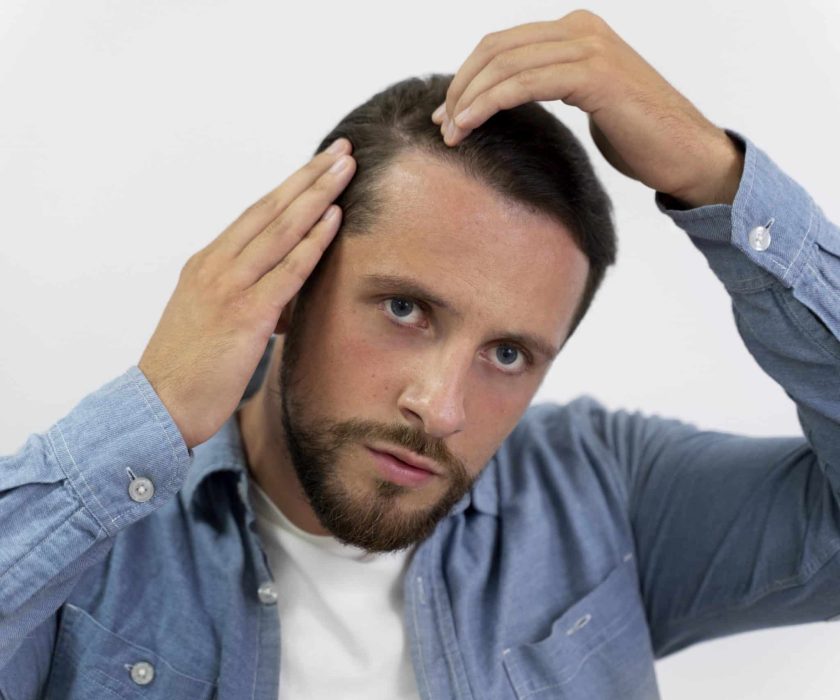Introduction
Baldness Overview
Baldness affects a large segment of the male and female population, with statistics suggesting that up to 80% of men and 50% of women will experience some degree of hair loss in their lifetime. This condition not only affects physical appearance, but also has significant effects on mental health and self-esteem. Many feel insecure and actively seek solutions, which can range from medical treatments to surgical options and natural remedies.
The Role of Customised Solutions
Customised solutions represent a targeted, tailor-made approach to dealing with baldness. Each individual has unique characteristics, such as hair type, genetics and lifestyle, that influence hair loss. Treatments such as hair transplantation, PRP therapies and specific topical products can be tailored to meet your specific needs. For example, hair transplantation may be ideal for those with clearly defined thinning areas, while topical solutions may offer effective results for those experiencing more widespread hair loss.
The Roots of Baldness: Causes and Triggers
Genetics and Family History
Baldness is often inherited, which means that your chances of developing thinning hair can be influenced by family history. If you have direct relatives who have suffered from baldness, you are more likely to face the same problem. Studies have shown that genetic variations can determine the sensitivity of hair follicles to androgen hormones, which are often related to androgenetic baldness.
Research has identified specific genes linked to baldness, such as AR (androgen receptor), which may increase your predisposition to this condition. In fact, male pattern baldness tends to follow a family pattern, which suggests that genetics is a determining factor in your risk of hair loss.
Environmental and Lifestyle Influences
Environmental influences play a significant role in the health of your hair. Factors such as pollution, exposure to chemicals and toxins can contribute to folliculitis and scalp health problems, accelerating the hair loss process. In addition, chronic stress has been shown to negatively affect hair growth, leading to conditions such as alopecia areata in your life cycle.
Your lifestyle is equally crucial: an unbalanced diet, lack of exercise and bad habits such as smoking can spell doom for your hair. Nutrients such as B-complex vitamins, iron and protein are crucial for keeping your hair follicles healthy and strong. Therefore, improving your diet and managing stress are key strategies in the fight against baldness.
For example, a diet rich in antioxidant foods such as fruit and vegetables not only supports your general well-being, but may also protect your hair from environmental damage. Integrating healthy habits, such as regular exercise and relaxation techniques, can help mitigate the negative effects on your scalp and, consequently, your hair.
Analysis of Traditional Baldness Solutions
Medications and Topical Treatments
The most common drugs to combat baldness include minoxidil and finasteride. Locally applied minoxidil stimulates blood circulation to the scalp and promotes hair growth. On the other hand, finasteride acts systemically by blocking the enzyme that converts testosterone into dihydrotestosterone (DHT), a hormone responsible for follicle miniaturisation. Studies show that about 60% of men using finasteride report some hair growth after one year of use.
However, it is essential to be aware of side effects, such as erectile dysfunction or changes in mood. These treatments require constant use to maintain results, so it is important to have realistic expectations of progress over time. For some, a consultation with a dermatologist can help decide the best way to integrate these drugs into one's routine.
Aesthetic Surgery and Hair Transplantation
Cosmetic surgery for baldness has seen significant progress in recent years. Among the most widely used techniques are follicular unit transplantation (FUT) and follicular unit extraction transplantation (FUE). Both methods involve taking follicles from a donor area, typically the back of the head, and then implanting them into bald areas. These procedures can offer permanent and natural results, but require a thorough evaluation to determine your suitability.
In recent years, hair transplant results have improved, thanks to the use of advanced technologies such as robotics and microscopy for optimal precision. Every patient has unique needs, and preliminary assessments can help customise the procedure, maximising final satisfaction. Considering a consultation with certified experts is essential to explore this option and define an appropriate plan of action.
Technological Innovations in the Treatment of Baldness
Regenerative Therapies and Stem Cells
Regenerative therapies represent one of the most significant advances in the treatment of baldness. Using stem cells taken from your own body, these techniques aim to stimulate hair growth by regenerating follicles. Recent studies have shown that injecting stem cells into the scalp can increase hair density and slow down the thinning process. Delving deeper into the subject, you may find that an increasing number of clinics offer protocols based on this innovative approach, often combining them with other therapies to maximise results.
The process of stem cell harvesting and its subsequent application requires careful planning and specialised expertise. Investing in these therapies is not only an aesthetic innovation, but also an opportunity to rediscover your self-confidence. It is essential to consult experts in the field to assess the suitability of regenerative therapies according to your specific type of baldness and your general state of health.
Laser Approaches and Photodynamic Therapy
Laser approaches have established themselves as effective methods of treating baldness, using advanced technologies to stimulate hair growth. Low-Level Laser Therapy (LLLT) treatments are designed to increase blood circulation in the scalp, promoting cellular activity and follicle rebirth. In many clinics, these devices are used in combination with other more traditional treatments, resulting in an integrated approach to combat baldness.
Photodynamic therapy, on the other hand, uses light and photosensitive substances to treat thinning hair. This method not only acts locally to stimulate growth, but may also offer long-term benefits in improving scalp health. The joint implementation of these technologies represents a promising frontier in the baldness treatment landscape, addressing the problem from multiple angles and increasing the possibility of satisfactory results.
By incorporating these innovative approaches, the chances of achieving thicker and healthier hair are remarkably high. Professionals and state-of-the-art equipment in clinics offering these treatments can provide the necessary assistance to enhance their success. Contacting experienced professionals can offer you a personalised analysis and practical suggestions on how to integrate these new methods into your hair loss treatment plan.
Customising Treatments: Towards a Customised Solution
Consultation and Individualised Diagnosis
Your experience in the fight against baldness starts with a detailed consultation. During this meeting, an expert will analyse your scalp, assess your family history and study your lifestyle to determine the specific causes of your hair loss. Advanced diagnostic tools, such as trichographs and skin microbiome analysis, can be used to provide a clear picture of your unique situation.
This phase is crucial because it allows you to create an accurate picture of your health status and the factors that may influence treatment. Each person reacts differently to various treatment approaches and, by understanding your individual needs, it will be possible to define a truly efficient course of action.
Development of a Customised Treatment Plan
Once the diagnosis has been completed, the next step is to develop a customised treatment plan. This plan is not just a list of procedures, but a holistic approach combining different methodologies such as drug therapy, topical interventions and, if necessary, surgical techniques such as hair transplantation. For instance, the introduction of specific supplements to strengthen follicles or the use of low-intensity laser therapy can be evaluated according to your particular condition.
The plan takes into account factors such as age, degree of hair loss, and any allergies or sensitivities. Appendices such as regular follow-up are essential to monitor progress and make changes when necessary, ensuring that your treatment always remains aligned with your evolving needs.
Testimonials and Recommendations: Voices of Those Who Tried It
Positive Experiences and Achievements
Many people who have faced baldness share their positive experiences after following customised treatments. Some users, after starting therapy with finasteride and minoxidil products, notice a significant improvement in hair density already after six months. A case in point is that of Marco, who achieved astonishing results with a mix of laser therapy and topical treatments, reporting a 70% increase in active follicles after one year. These success stories confirm that a targeted approach can make all the difference in the fight against hair loss.
Experiences are not only limited to chemical treatments. Even those who have opted for surgical solutions, such as hair transplantation, speak of appreciable results. Laura, for example, saw significant regrowth in several thinning areas after surgery. Positive reviews point not only to an aesthetic improvement, but also to an increase in self-confidence and a better quality of life, as patients feel more comfortable with their appearance.
Mistakes to Avoid and Practical Advice
Coping with baldness can be complicated, and mistakes are often made that slow down progress. A common mistake is to skip follow-up visits with experts, thus missing the opportunity to monitor the effectiveness of the treatment and make necessary changes. In addition, many people tend to rely on unproven remedies or do-it-yourself treatments, which can lead to disappointing results and, in some cases, damage to the scalp. It is essential to follow a well-defined plan and always consult a professional before embarking on new initiatives.
Another practical tip is to maintain a proper hair care routine. Using gentle shampoos and nutritional treatments can promote a healthy scalp. Patience plays a key role; results often take time and progress can be gradual. Creating a diary to record your observations and changes can help you stay motivated, as hair loss is a long journey that can be tackled with the right strategy and perseverance.
Conclusion
In conclusion, customised hair loss solutions offer a targeted approach to address the different needs and concerns related to hair loss. By analysing the specific causes of your condition and implementing appropriate treatments, you can significantly improve the health of your hair and your overall appearance. Remember to consult experts in the field who can guide you in choosing the most suitable options for you.
Investing in tailor-made solutions not only boosts your chances of regaining your hair, but also your self-confidence. Make sure you follow a consistent routine and consider your personal preferences, because every small step towards thicker hair can prove to be crucial in your path to rebirth. Your journey to an effective solution is at hand and, with the right guidance, you can tackle baldness with confidence and determination.
FAQ
Q: What are customised solutions for baldness?
A: Customised solutions for baldness include treatments and products specifically designed to meet the individual needs of hair loss sufferers, such as shampoos, lotions, supplements and surgery.
Q: How can I determine which solution is right for me?
A: It is advisable to consult a dermatologist or an expert for a thorough assessment of your hair type and stage of baldness, so that you can receive customised recommendations.
Q: Are baldness solutions effective for everyone?
A: The effectiveness of baldness solutions varies from person to person and depends on several factors, such as the cause of the baldness and adherence to the recommended treatment. It is important to follow the practitioner's instructions and have realistic expectations.










